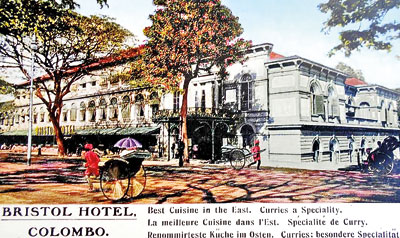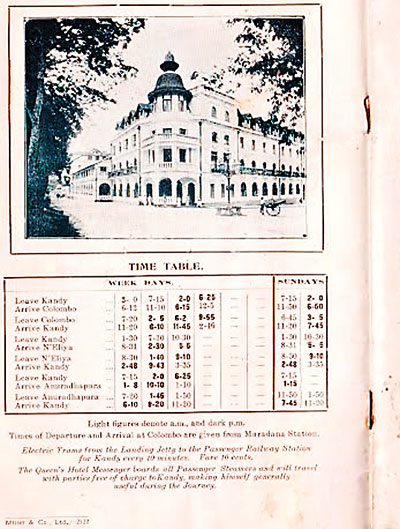When holidaying here was a genteel affair
 It is 50 years ago this month that the Ceylon Tourist Board was established marking the official commencement of planned tourism development and regulation in Sri Lanka. The Board – now known as Sri Lanka Tourism – was the successor to the Government Tourist Bureau that had offices in Colombo, London and Bombay. Tourists, however, had been coming here on holiday since the 19th Century, which is when many hotels still in business today first opened.
It is 50 years ago this month that the Ceylon Tourist Board was established marking the official commencement of planned tourism development and regulation in Sri Lanka. The Board – now known as Sri Lanka Tourism – was the successor to the Government Tourist Bureau that had offices in Colombo, London and Bombay. Tourists, however, had been coming here on holiday since the 19th Century, which is when many hotels still in business today first opened.
Sri Lanka’s enviable collection of historic Victorian and Art Deco hotel buildings contrasts both architecturally and in ambience with modern mainstream package hotels, trendy boutique villas and backpacker guesthouses. Those hotels of character, built before there were any government regulations or official promotion of tourism, remain as a testament to how holidaying here was a genteel affair in the past.
In the days of steam ships, before aeroplanes and automobiles were invented, travellers disembarked at Galle harbour and stayed there before travelling to Colombo by horse-drawn carriage or, from 1894, by train. The hotel where new arrivals stayed was called the New Oriental Hotel, but this was neither New nor Oriental, but defiantly colonial in design.
A Regency-style building with sandstone walls one metre thick and wooden ceilings six metres high, the hotel grew out of a barracks built in 1684 by the Dutch to house army officers.This was eventually occupied by officers of the British 83rd Regiment and thus it can be considered the oldest hotel building in the island.The NOH, as it became known, was licensed to operate as an Inn in 1865 and, up to the time it closed in 2003, retained the languor and must of antiquity. It has since been gentrified and reinvented as the Amangalla Hotel.
Passengers arriving at Colombo by sea would have been gratified to see a solid, respectable looking hotel right by the harbour gates, the Grand Oriental. According to a review published in 1907, “The Grand Oriental Hotel (or GOH as it is familiarly known far and wide) was the first of the modern type of imposing hotels erected in the East. With its towering front facing the harbour and the shipping and its main portico separated by only a few yards from the principle landing stage, it occupies both a commanding and convenient position; and passengers by the mail steamers who are passing through the port are especially catered for at this establishment in the very best style…The building contains 154 bedrooms…The hotel is lighted throughout by electricity and all the public rooms and bedrooms are kept cool by means of electric fans.”
The managing director of the GOH from 1901, Wm Tudor Stephen Saunders, had arrived in Ceylon in 1868 and worked as a planter before he sold his plantation and, “settled down in Colombo and was instrumental in starting the Bristol Hotel, of which he was the first managing director. Leaving the Bristol Hotel in 1901, he became the managing director of the Grand Oriental Hotel…He was also the managing director of the Ceylon Railway Refreshment Car Company, the Hatton Hotel, and the Grand Hotel at Nuwara Eliya.”
Like the NOH, the GOH was originally built (in 1837) to house the military and only became a hotel in 1875 to fulfil the demand for accommodation near the port. The Bristol Hotel was its neighbour in York Street and advertised itself on a postcard (in English, French and German, thus revealing the nationalities of tourists over a century ago) as having “Best cuisine in the East” and “Curries a Speciality.” On the reverse of the postcard are “Useful notes on arrival at Colombo” giving the hotel tariff as Rs 6.00 for a double room, with breakfast an extra Rs. 2.00. Carriages cost Rs.1 for an hour’s city tour, while rickshaw hire (pulled by a man not a horse) was 10 cents for 10 minutes.
The doyen of historic hotels in Colombo was, and still is, the Galle Face Hotel. This grew out of a private bungalow, Galle Face House, at the southern end of Galle Face Green. During the time of Governor Sir Colin Campbell (1841-47) a 30-pound cannon ball fired during an artillery practice pitched through the roof and landed in the drawing room, an event now commemorated annually at the hotel. It was the first hotel in the country to have a swimming pool.
Twentieth Century Impressions of Ceylon, published in London in 1907, states: “The Galle Face Hotel is renowned not only throughout the Orient but also wherever travellers who have passed through Colombo are to be found…The architecture of the huge building is Renaissance style, and the interior arrangements are on a scale befitting the exterior…Suites of rooms with private bathrooms attached and elaborately furnished apartments are provided on every floor, while over 200 bedrooms are included in the sleeping accommodation, also bathrooms for ladies and gentlemen on each floor. The management is entirely European. Established over 20 years ago, the hotel was entirely rebuilt in 1894 and now it can claim to be provided with every comfort and convenience.”

From the same source we learn that: “Mount Lavinia Grand Hotel is a favourite seaside resort with visitors to Ceylon…it is particularly suited for the rest and recuperation of invalids and sufferers from the debilitating effects of the city climate.” The hotel was previously a rest house, having originated as the country residence of Governor Sir Edward Barnes (1824-31). It was converted in 1900 into a sanatorium to accommodate convalescing Boer prisoners of war. A military barracks beside the railway line was adapted as a hospital before it too become part of the hotel.
Sir Edward Barnes has a connection with another hotel of character, The Grand Hotel in Nuwara Eliya. This has its origins in the hill country bungalow he built there. It became known as Barnes Hall and is recorded on a map of the area, dated 1862, as being a hotel, so today’s Grand Hotel is actually over 150 years old, but it is not the country’s oldest. In 1891, the owning company, Nuwara Eliya Hotels Company Limited, was formed to own and operate the property but the hotel was not transferred to the company until April 12, 1892. So next year (2017) will see the 125th anniversary of that event.
In 1907 it was reported that: “At Nuwara Eliya the competition between the four different hostelries established there is very keen and the visitor begins to realise how much he is sought after when representatives of each establishment appear determined to bear him off vi et armis.” The four hotels would have included The Grand, St Andrew’s Hotel, originally begun as a planters’ club, and The Pedro View Hotel, part of an Indian-owned enterprise begun in 1869.
In neighbouring Bandarawela, the burrowing through the hills of the railway line in 1894 brought travellers to the Bandarawela Hotel which opened the same year. Tourists have been staying there ever since. The original concept was an exclusive planters’ club and guest house for Europeans. While other old hotels revamp themselves, the Bandarawela Hotel prospers because it seems that not much changes; it remains reassuringly locked in a time warp. I chose the hotel for the celebration of my own half-century, forging a link with the hotel that makes me still feel 50 years old whenever I stay there, as nothing seems to have changed since then.
In Anuradhapura there was another grand hotel popular at the beginning of the last century that time has forgotten. Unable to compete with modern hostelries, it shed the appellation Grand and became the Tissawewa Rest House for decades. It was recently renovated and still exists with its vintage atmosphere restored as The Sanctuary at Tissawewa.
The accolade of being the oldest, purpose built grand hotel in Sri Lanka must go to The Queen’s in Kandy. Twentieth Century Impressions of Ceylon records: “One of the most popular hotels up country is the Queen’s Hotel, Kandy, and the increasing patronage of European visitors has rendered its enlargement necessary. It was opened in 1849 and was improved and enlarged about ten years ago” [ie: in 1897].
Its neighbour in Kandy, The Suisse Hotel, rivals it in age having originally (in the 17th century) been the residence of the Chief Minister of the Royal Granary. In 1818 it was acquired by the British and named Haramby House. Later, it was taken over by a Swiss lady who ran it as a guest house before it became a hotel.
It was not until the 1930s that tourism spread to the east coast with the building of the first hotel in Trincomalee. A British resident, M.S. Milne, saw the possibilities of good business from the British navy personnel stationed in Trincomalee and in 1937 opened The Welcombe Hotel.It soon became the social hub of the area, and was very popular with visitors touring the country. In December 1938, a tourist sent a postcard to England depicting an enticing view of the hotel. On the back she wrote: “This is a very good hotel. I am enjoying my trip immensely, much more than I expected. We are going on to Polonnaruwa today, Sigiri & Kandy tomorrow. Then Nuwara Eliya, Haputale, Hambantota, Galle & Colombo.”
It is thanks to independent visitors from Europe in the19th and early 20th centuries that tourism began in Sri Lanka. That some of those pioneering hotels are still flourishing is evidence of the enduring success of this country’s tourism industry.


